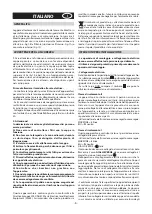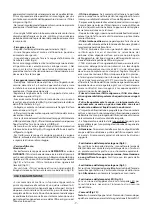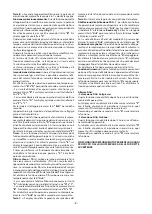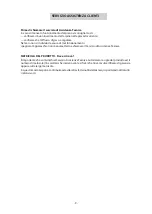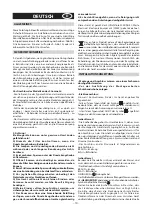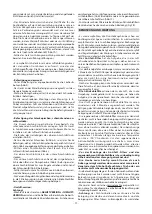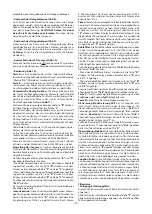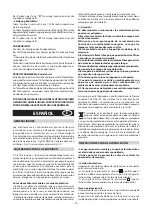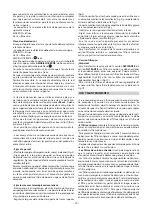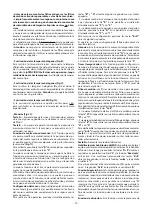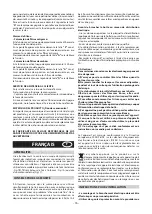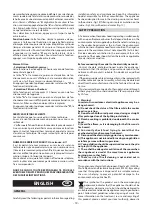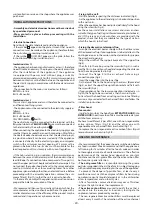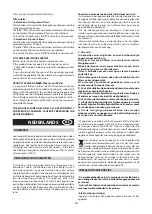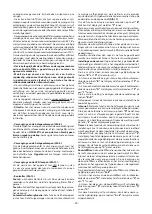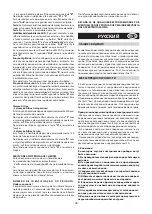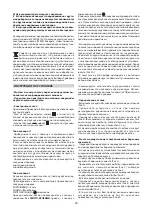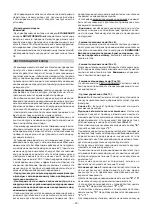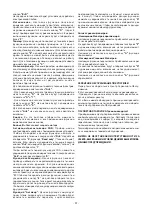
- 20 -
waste collection service or the shop where the appliance was
purchased.
INSTALLATION INSTRUCTIONS
• Assembly and electrical connections must be carried out
by specialised personnel.
• Wear protective gloves before proceeding with the
installation.
• Electric Connection:
Note! Verify the data label placed inside the appliance:
- If the symbol appears on the plate, it means that no earth
connection must be made on the appliance, therefore follow
the instructions concerning insulation class II.
- If the symbol DOES NOT appear on the plate, follow the
instructions concerning insulation class I.
Insulation class II
- The appliance has been manufactured as a class II, therefore
no earth cable is necessary. The plug must be easily accessible
after the installation of the appliance. If the appliance
is equipped with power cord without plug, a suitably
dimensioned omnipolar switch with 3 mm minimum opening
between contacts must be fitted between the appliance and
the electricity supply in compliance with the load and current
regulations.
- The connection to the mains is carried out as follows:
BROWN =
L
line
BLUE =
N
neutral.
Insulation class I
This is a class I, appliance and must therefore be connected to
an effiecient earthing system.
- The appliance must be connected to the electricity supply as
follows:
BROWN =
L
line
BLUE =
N
neutral
YELLOW/GREEN
= earth.
The neutral wire must be connected to the terminal with the
N
symbol while the
YELLOW/GREEN
, wire must be connected
to the terminal by the earth symbol .
When connecting the appliance to the electricity supply, make
sure that the mains socket has an earth connection. After fitting
the ducted cooker hood, make sure that the electrical plug is
in a position where it can be accessed easily. If the appliance
is connected directly to the electricity supply, an omnipolar
switch with a minimum contact opening of 3 mm must be
placed in between the two; its size must be suitable for the
load required and it must comply with current legislation.
•
If the hob is electric, gas, or induction, the minimum distance
between the same and the lower part of the hood must be at
least
65 cm
. If a connection tube composed of two parts is
used, the upper part must be placed outside the lower part. Do
not connect the cooker hood exhaust to the same conductor
used to circulate hot air or for evacuating fumes from other
appliances generated by other than an electrical source. Before
proceeding with the assembly operations, remove the anti-
grease filter(s) (Fig.7A) so that the unit is easier to handle.
- In the case of assembly of the appliance in the suction version
prepare the hole for evacuation of the air.
•
We recommend the use of an air exhaust tube which has the
same diameter as the air exhaust outlet hole. If a pipe with a
smaller diameter is used, the efficiency of the product may be
reduced and its operation may become noisier.
• Fixing to the wall:
- Drill the holes
A
respecting the distances indicated (Fig.2).
- Fix the appliance to the wall and align it in horizontal position
to the wall units.
- When the appliance has been adjusted, definitely fix the hood
using the screws
A
(Fig.5).
For the various installations use screws and screw anchors
suited to the type of wall (e.g. reinforced concrete, plasterboard,
etc.). If the screws and screw anchors are provided with the
product, check that they are suitable for the type of wall on
which the hood is to be fixed.
• Fixing the decorative telescopic flue:
- Arrange the electrical power supply within the dimensions
of the decorative flue. If your appliance is to be installed in the
ducting version or in the version with external motor, prepare
the air exhaust opening.
- Adjust the width of the support bracket of the upper flue
(Fig.3).
- Then fix it to the ceiling using the screws
A
(Fig.3) in such a
way that it is in line with your hood and respecting the distance
from the ceiling indicated in Fig.2.
- Connect the flange
C
to the air exhaust hole using a
connection pipe (Fig.5).
- Insert the upper flue into the lower flue.
- Fix the lower flue to the hood using the screws
B
provided
(Fig.5), extract the upper flue up to the bracket and fix it with
the screws
B
(Fig.3).
- If your appliance has the lower connections indicated as in
Fig.4A, the fixing to be carried out is that shown in Fig.6A.
To transform the hood from a ducting version into a filtering
version, ask your dealer for the charcoal filters and follow the
installation instructions.
• Filter hood:
Please note:
- In order to transform the hood from
EXTRACTOR HOOD
into
FILTER HOOD
the active carbon filters must be ordered at your
distributor as accessory.
We have two different types of Kit, one with non-regenerable
active carbon filters (Fig.7B) and the other one with
regenerable active charcoal filters (washable) (Fig.7C).
- To replace the non-regenerable active carbon filters
X
, pull
lever outwards as shown in Fig.7B.
USE AND MAINTENANCE
•
We recommend that the cooker hood is switched on before
any food is cooked. We also recommend that the appliance is
left running for 15 minutes after the food is cooked, in order
to thoroughly eliminate all contaminated air. The effective
performance of the cooker hood depends on constant
maintenance; the anti-grease filter and the active carbon filter
both require special attention.
• The anti-grease filter
is responsible retaining the grease
particles suspended in the air, therefore it is subject to clogging
with variable frequency according to the use of the appliance.
- To prevent the danger of possible fires, at least every 2
months one must wash the anti-grease filters by hand using
non-abrasive neutral liquid detergents or in the dishwasher
at low temperatures and on short cycles.
- After a few washes, colour alterations may occur. This does
not give the right to claim their replacement.
• The active carbon filters
are used to purify the air that is
sent back into the room and its function is to mitigate the
unpleasant odours produced by cooking.
- The non-regenerable active carbon filters must be replaced
at least every 4 months. The saturation of the active charcoal
Summary of Contents for 36900571
Page 2: ......
Page 3: ... 3 M max 90 cm 20 235 Fig 4 Fig 2 Fig 3 Fig 5 Fig 1 ...
Page 4: ... 4 A B C Fig 9 Fig 8 Fig 7 Fig 6 Fig 10 ...
Page 5: ... 5 Fig 11 Fig 12 ...
Page 32: ...3LIK1729 ...

